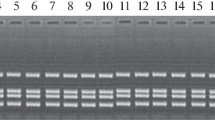Abstract
Spontaneous mutants with altered capsule synthesis were isolated from a marked strain of the symbiont,Rhizobium japonicum. Differential centrifugation was used to enrich serially for mutants incapable of forming capsules. The desired mutants were detected by altered colony morphology and altered ability to bind host plant lectin. Three mutants failed to form detectable capsules at any growth phase when cultured in vitro or in association with the host (soybean,Glycine max (L.) Merr.) roots. These mutants were all capable of nodulating and attaching to soybean roots, indicating that the presence of a capsule physically surrounding the bacterium is not required for attachment or for infection and nodulation. Nodulation by several of the mutants was linearly proportional to the amount of acidic exopolysaccharide that they released into the culture medium during the exponential growth phase, indicating that such polysaccharide synthesis is important and perhaps required for nodulation. Two of the mutants appeared to synthesize normal lectin-binding capsules when cultured in association with host roots, but not when cultured in vitro. Nodulation by these mutants appeared to depend on how rapidly after inoculation they synthesized capsular polysaccharide.
Similar content being viewed by others
Abbreviations
- CPS:
-
capsular polysaccharide
- EPS:
-
exopolysaccharide
- FITC:
-
fluorescein isothiocyanate
References
Bal, A.K., Shantharam, S., Ratnam, S. (1978) Ultrastructure ofRhizobium japonicum in relation to its attachment to root hairs. J. Bacteriol.133, 1393–1400
Bhuvaneswari, T.V., Bauer, W.D. (1978) Role of lectins in plantmicroorganism interactions. III. Binding of soybean lectin to root-cultured rhizobia. Plant Physiol.62, 71–74
Bhuvaneswari, T.V., Pueppke, S.G., Bauer, W.D. (1977) Role of lectins in plant-microorganism interactions. I. Binding of soybean lectin to rhizobia. Plant Physiol.60, 486–491
Bhuvaneswari, T.V., Turgeon, B.G., Bauer, W.D. (1980) Early events in the infection of soybean (Glycine max. L. Merr.) byRhizobium japonicum. I. Localization of infectible root cells. Plant Physiol.66, 1027–1031
Bohlool, B.B., Schmidt, E.L. (1974) Lectins: A possible basis for specificity in theRhizobium-legume root nodule symbiosis. Science185, 269–271
Bohlool, B.B., Schmidt, E.L. (1976) Immunofluorescent polar tips ofRhizobium japonicum: possible site of attachment or lectin binding. J. Bacteriol.125, 1188–1194
Calvert, H.E., Lalonde, M., Bhuvaneswari, T.V., Bauer, W.D., (1978) Role of lectins in plant-microorganism interactions. IV. Ultrastructural localization of soybean lectin binding sites ofRhizobium japonicum. Can. J. Microbiol.24, 785–793
Darvill, A.G., McNeil, M., Albersheim, P. (1978) Structure of plant cell walls. VIII. A new pectic polysaccharide. Plant Physiol.62, 418–422
Dazzo, F.B. (1980) Adsorption of microorganisms to roots and other plant surfaces. In: Adsorption of microorganisms to surfaces, pp. 253–316, Bitton, G., Marshall, K.C., eds. Wiley Interscience, New York
Dazzo, F.B., Hubbell, D.H. (1975) Cross-reactive antigens and lectins as determinants of symbiotic specificity inRhizobium trifolii-clover association. Appl. Microbiol.30, 1017–1033
Dudman, W.F., Jones, A.J. (1980) The extracellular glucans ofRhizobium japonicum strain 3IIb 71a. Carbohydr. Res.84, 358–364
Duguid, J.P. (1951) The demonstration of bacterial capsules and slime. J. Pathol. Bacteriol.63, 673–685
Hammarström, S., Murphy, L.A., Goldstein, I.J., Etzler, M.E. (1977) Carbohydrate binding specificity of four N-acetyl-D-galactosamine-“specific” lectins:Helix pomatia A hemagglutinin, soybean agglutinin, lima bean lectin andDolichos biflorus lectin. Biochem.16, 2750–2755
Kuykendall, L.D., Elkan, G.H. (1976)Rhizobium japonicum derivatives differing in nitrogen fixing efficiency and carbohydrate utilization. Appl. Environ. Microbiol.32, 511–519
Lis, H., Sela, B., Sachs, L., Sharon, N. (1970) Specific inhibition by N-acetylgalactosamine of the interaction between soybean agglutinin and animal cell surfaces. Biochim. Biophys. Acta211, 582–585
Marshall, K.C., Cruickshank, R.H., Bushby, H.V.A. (1975) The orientation of certain root-nodule bacteria at interfaces, including legume root-hair surfaces. J. Gen. Microbiol.91, 198–200
Mort, A.J., Bauer, W.D. (1981) Application of two new methods for cleavage of polysaccharides into specific oligosaccharide fragments. Structure of the capsular and extracellular polysaccharides ofRhizobium japonicum that bind soybean lectin. J. Biol. Chem.257, 1870–1875
Mort, A.J., Bauer, W.D. (1980) Composition of the capsular and extracellular polysaccharides ofRhizobium japonicum. Changes with culture age and correlations with binding of soybean seed lectin to the bacteria. Plant Physiol.66, 158–163
Nakane, P.K., Kawaoi, A. (1974) Peroxidase-labeled antibody. A new method of conjugation. J. Histochem. Cytochem.22, 1084–1091
Napoli, C., Albersheim, P. (1980)Rhizobium leguminosarum mutants incapable of normal extracellular polysaccharide production. J. Bacteriol.141, 1451–1456
Sanders, R., Raliegh, E., Signer, E. (1981) Lack of correlation between extracellular polysaccharide and nodulation ability inRhizobium. Nature (London)292, 148–149
Sanders, R.E., Carlson, R.W., Albersheim, P. (1978) ARhizobium mutant incapable of nodulation and normal polysaccharide secretion. Nature (London)271, 240–242
Shimshick, E.J., Herbert, R.R. (1978) Adsorption of rhizobia to cereal roots. Biochem. Biophys. Res. Commun.84, 736–742
Stacey, G., Paau, A.S., Brill, W.F. (1980) Host recognition in theRhizobium-soybean symbiosis. Plant Physiol.66, 609–614
Tsien, H.C., Schmidt, E.L. (1977) Polarity in the expponential phaseRhizobium japonicum cells. Can. J. Microbiol.23, 1274–1284
Tsien, H.C., Schmidt, E.L. (1981) Localization and partial characterization of soybean lectin-binding polysaccharide ofRhizobium japonicum. J. Bacteriol.145, 1063–1074
Turgeon, B.G., Bauer, W.D. (1982) Early events in the infection of soybean byRhizobium japonicum. Time course and cytology of the initial infection process. Can. J. Bot.60 (in press)
Werner, D., Stripf, R. (1978) Differentiation ofRhizobium japonicum. I. Enzymatic comparison of nitrogenase repressed and derepressed free living cells and of bacteroids. Z. Naturforsch.33b, 245–252
Author information
Authors and Affiliations
Additional information
Contribution No. 719 of the C.F. Kettering Research Laboratory
Rights and permissions
About this article
Cite this article
Law, I.J., Yamamoto, Y., Mort, A.J. et al. Nodulation of soybean byRhizobium japonicum mutants with altered capsule synthesis. Planta 154, 100–109 (1982). https://doi.org/10.1007/BF00387901
Received:
Accepted:
Issue Date:
DOI: https://doi.org/10.1007/BF00387901




